Why Are There Water Stains On My Ceiling Around the AC Vents?
December 15, 2021
Have you noticed water stains or dark spots on the ceiling next to the AC vents?
It’s a common problem in Southwest Florida that you don’t want to ignore, as water damage is pricey to remedy, and the moisture in a high-humidity state like ours can encourage mold growth and rotting drywall. Unfortunately, painting over the stains will not resolve the root problems.
You’ll want to address these 4 root problems that lead to ceiling water stains:
- Clogged condensate drain line
- Cracked condensate drain pan
- Under-insulated air ducts and vent boots
- Ductwork leaks
We’ll explain why you see these water stains and how to resolve these 4 problems. You'll prevent these problems from occurring again and have a pristine ceiling once more. We'll also go over what you need to do before repainting.
Want to inspect and repair any AC problems ASAP?
With a 100% satisfaction and punctuality guarantee, Advanced Air technicians provide round-the-clock, respectful AC repairs and ductwork sealings for Southwest Florida homeowners. Experience our 5-star service today! Call us at (888) 853-5143 or schedule below.
Clogged Condensate Drain Line
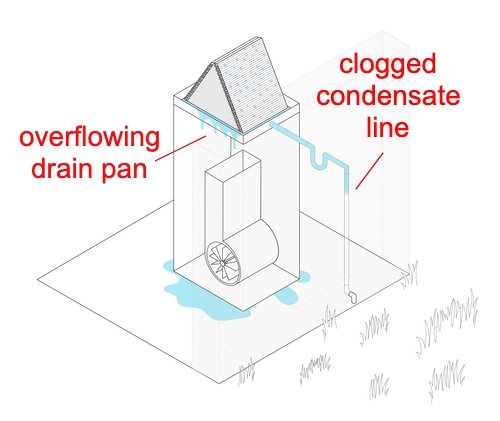
Where to located a condensate drain line
Three parts help AC systems cool and dehumidify homes:
- The evaporator coil
- The condensate drain pan
- The condensate drain line
First, an evaporator coil in the indoor AC unit hosts a cold, chemical agent that cools the air when warm indoor air blows over it. And when the warm air touches the cold coil, condensation forms on it.
Second, the condensation drips off of the evaporator coil into the condensate drain pan underneath the coil.
Third, the condensate drain line funnels the collected moisture outside the house.
However, the drain line can clog with fungi, algae, and other debris over time. When this occurs, the clogged condensate drain line will cause the unit to overflow, leading to water stains and dark spots on the ceiling if your AC system is in the attic.
How to Fix
Unclogging a condensate drain line is as easy as scheduling an AC tune-up. The technician will clear out debris and buildup from the drain line, preventing it from backing up.
You’ll also want to install a float switch. The float switch is a device that can detect if water is backing up due to a clogged drain line. If so, the switch will shut off the cooling system and prevent water from overflowing. If your system already has a float switch, it might need replacement.
Cracked Condensate Drain Pan
Above, we talked about how a clogged condensate drain line can cause water to overflow. In the same vein, water can also leak out if there are cracks or holes in the condensate drain pan, causing water stains on the ceiling.
How to Fix
You’ll want to:
- Use a wet/dry vacuum to suction out any water in the drain pan.
- Hire an HVAC technician to inspect the drain pan for cracks, rust, or holes. Then, the technician will either seal or replace it
Under-Insulated Air Ducts & Vent Boots

Under-insulated air ducts and vent boots have a similar effect to condensation on glass.
If you set a cold glass of water outside on a warm Florida afternoon, water drops will soon cover the glass (the process of condensation). The same thing happens with ductwork and warm, moist unconditioned attic air.
In a nutshell: Cold ducts + warm, moist air = condensation = water stains
When there isn’t enough insulation around the air ducts or vent boots, the ducts get cold. Warm attic air touching cold, under-insulated ducts or vent boots forms condensation, especially in Florida, the most humid state in the nation. The condensation then leaks through the ceiling, creating water stains and rotting drywall
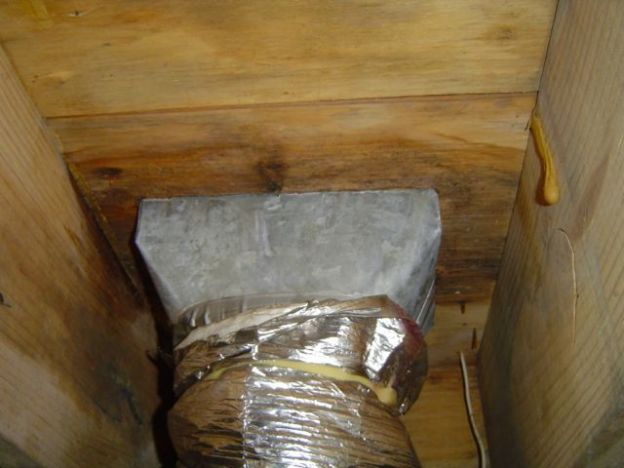
Insulating boots can lower the risk of water stains on ceilings. / Source: Department of Energy
What is a vent boot? Older Florida homes have a piece of sheet metal that connects the ending of a duct and the vent. Newer constructed homes should already have insulated vent boots.
How to Fix
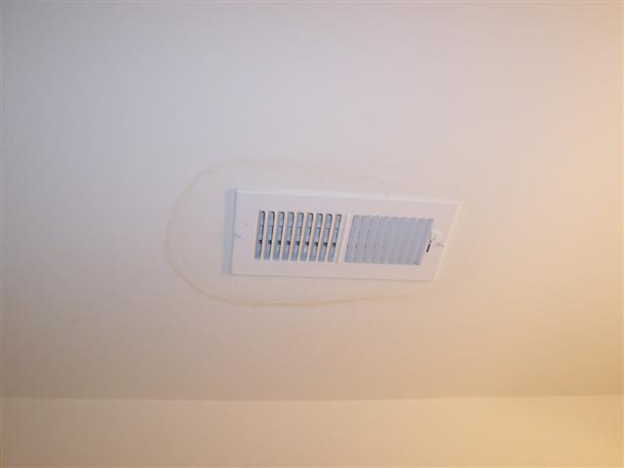
Prevent water stains by insulating your air ducts and vent boots.
Beyond water stains on the ceiling or spotting water vapor on the AC vents, you might have under-insulated air ducts or vent boots if your AC struggles to maintain a comfortable temperature on sweltering days.
Air ducts and vent boots should be well insulated to prevent warm attic air from touching cold ductwork. Not to mention insulating these parts keeps indoor temperatures consistent, causing your AC to work less and saving you money on bills.
You’ll want to hire a professional to wrap up the air ducts in unconditioned spaces in your home. It’s best to also insulate the vent boot itself with fiberglass insulation to prevent them from getting cold and dripping water through your ceiling.
Note: If your ductwork is old or damaged, have it repaired and sealed before insulation, which we’ll cover below.
Ductwork Leaks
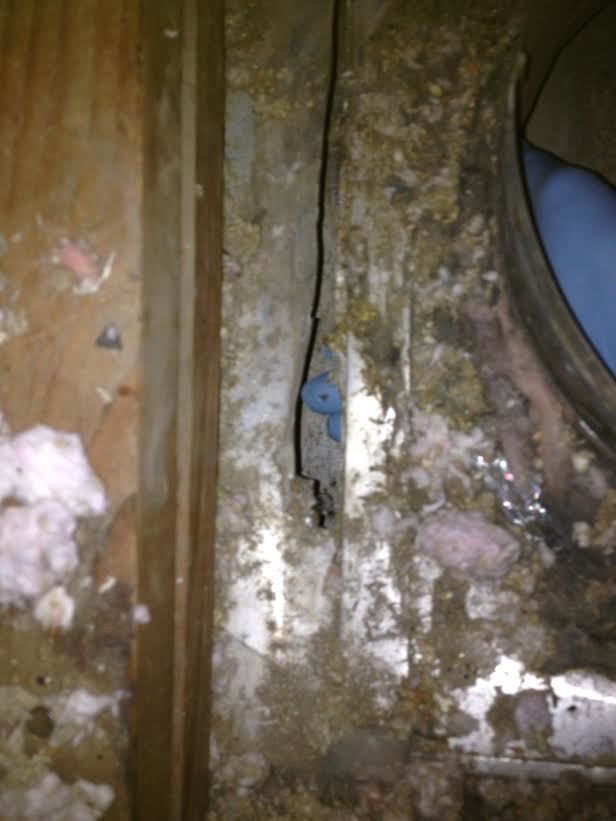
Leaky ductwork can cause ceiling water stains.
Ductwork leaks occur when there are:
- Improperly attached vent boots to ducts
- Improperly sealed vents to drywalls
- Holes or leaks in the ductwork
Ductwork leaks cause conditioned air to come into contact with warm attic air, thereby creating condensation. Water then drips down from the ductwork onto the ceiling, forming stains and spots.
How to Fix
If there is a leak between the vent boot and the duct, you can seal it with a mastic sealer.
If there is a leak between the vent and the drywall, you can seal the leak using caulk.
If there are holes or leaks in the ductwork, an expert can seal the ductwork. At Advanced Air, we don’t use manual duct sealing with mastic tape; we use Aeroseal. It’s an injectable sealant that seals leaks from the inside, ensuring complete sealant and no reopening in the near future.
If you aren’t sure where the leak is or aren’t comfortable sealing the leak yourself, contact an HVAC technician to inspect and seal your air vents, vent boots, and ducts.
Painting Over Ceiling Water Stains
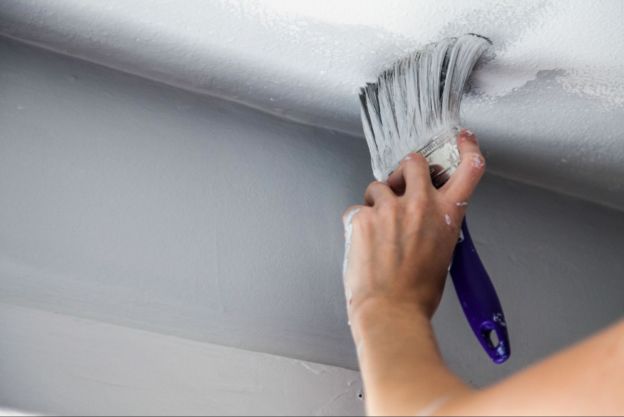
Prime the ceiling before painting over water stains.
Here is a checklist of addressing ceiling water stains before repainting:
- Address the 4 HVAC and ductwork root problems causing water stains
- Check with mold remediation and water damage specialists
- Check if condensation is still forming on your AC vents
Once you’ve stopped seeing condensation on your AC vents, you can now paint over and replace stained drywall without worrying about the stains coming back.
This type of water stain needs a primer before you paint over it. You’ll want to prime the ceiling with KILZ 2 water-based paint primer or a similar product. Then, you can use a few coats of standard paint.
Want To Stop Ceiling Stains? Contact Advanced Air.

Contact Advanced Air to stop ceiling water stains from occurring again.
Since 1989, Advanced Air has promised to keep Southwest Florida homeowners comfortable. We’ve consistently provided 5-star service and some of the best guarantees in the state. For example, we have a 100% satisfaction guarantee, and we'll pay you if we're even a minute late to your appointment.
Call us today at (888) 853-5143 or schedule below for an AC repair (e.g., clogged condensate drain line or cracked drain pan) or ductwork sealing.
- Posted in:
- Air Conditioning



